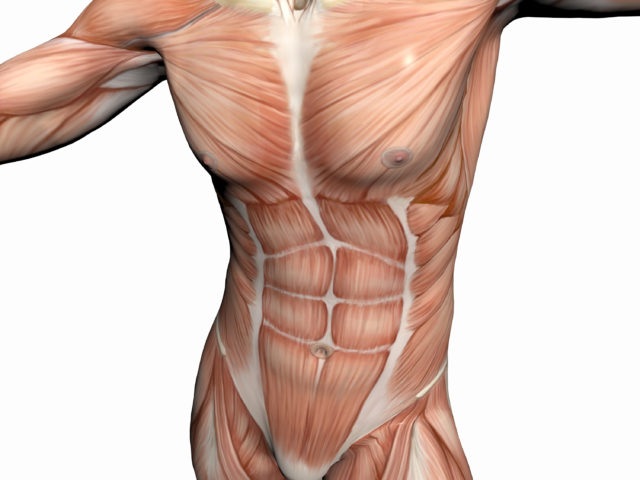Core Stability is a frequently used phrase in the health, fitness and the sporting industries. But when I look around at the quality of training that presents itself, I can see that training the “Core” is a very misunderstood subject.
What Is The Core?
If you take away your arms, legs and your head, you are basically left with the core, your back and abdominals. The Core is the only thing that joins our upper body to our lower body.
Although the rib cage houses and protects all of the major organs in the upper thorax, it is the four layers of abdominal muscle that support and protect the viscera (organs) of the lower thorax. These four muscle layers wrap around the entire abdomen in multiple directions.
When working properly they also assist in supporting good circulation and healthy organ function. Another major function of the abdominal wall is to stabilise our spine. The Core is the foundation for all our movement.
Layers Of Abdominal Wall
The deepest layer is the Transverse Abdominals. It runs horizontally just like a weight belt or corset and is in fact is our own natural weight belt/corset.
With connections to the diaphragm, pelvic floor and low back or thoracolumbar fascia in more technical terms the transverse abdominals are important when it comes to stabilisation of the lumbar spine providing they are functioning.
The next layers of the Abdominal Walls are the External and Internal Oblique Muscles. These muscles run diagonally across your trunk. Their job is to rotate our trunk and assist in side bending movements.
Then there is the Rectus Abdominis, which is the top layer of the abdominal wall. You can often hear this referred to as the “wash board” or “six packs”.
This section of the Abdominal Wall acts like a shield to protect our organs. They are one big sheath of muscle that attaches from the upper ribs and xiphoid process right down to the pelvic bone.
It has two different neural functions, driven by two different nerves, so when the upper abdominal moves, the lower acts as a stabiliser and you have the reverse when the lower is being worked or moving.
This muscle is commonly trained inadequately and too often with poor quality crunch style exercises.
In the Core, the Rectus Abdominis are considered the outer unit of the abdominal wall. When over trained or tight, this muscle can pull people into what’s known as flexion, basically a round shoulder, forward head posture.
The many layers of abdominal wall wrap around our trunk in many directions, just like a package that has been wrapped for a long journey.
The core has eight different neural functions and as such this makes it a very complex area. What that means is that there are eight different nerves that facilitate the control and function of the core from the brain.
To train the core/abdominal wall properly you should first be assessed to determine where the weaker portions of it are.
You cannot determine a proper course of training and strengthening without a clinical assessment to determine the correct course of action to correct imbalances and apply the right training methods.
In many years of testing abdominal wall function, more often than not I find weakness in the deep layers rather than the outer layers. Of course this is a generalization.
Quite often the rectus abdominis (6 pack) although not always strong is stronger than the inner and lower layers that support our spine and pelvis.
If the deep layers of abdominal wall do not function correctly, there will be limited, poor support for the spine.
This amongst other postural positions creates pain to many degrees in people.
This in turn places different stress on our limbs and it can reflect the pain or discomfort anywhere, from the neck, shoulder, hip, knee and ankle; they can all be affected if the spine is not stabilized by the core musculature.
You could relate this to the trunk of a tree. If the tree trunk is weak the branches could not get the required support and so they themselves could not be strong.
Once assessed the weak portion of abdominal wall should be isolated to regain neural function (brain body connection) however this is not enough.
Once this has been achieved it is extremely important to integrate these muscles into all our functional movement patterns and exercises.
In everyday life no muscles work alone, they are a system, so it does not work to train them alone. Functional training can be related to big patterns that mimic human movement.
This type of training should integrate the body as a whole and not isolate it into little areas.
The only time muscles should be isolated is where there is weakness. E.g.: Transverse abdominals may be trained alone at first so the brain knows how to control and operate it.
Then it must be integrated into bigger patterns at a level the brain can still control and built up slowly into strength. If you train with more load than the weakness can handle the body will still do the job but something else will end up under load.
This creates faulty movement patterns, pain and dysfunction.
We are only as strong as our weakest link.
Things That Can Happen From A Weak Core:
Visarapatosis is an extremely common dysfunction, especially in women. This is when the deep abdominal wall is too weak to support the organs.
The weight of the organs slowly adds pressure to the intestinal tract and then it can prolapse.
This can shut down many functions within the body and is a major form of stress and embarrassment as one can’t control their vital functions.
Correcting the muscle imbalance and positioning within the core can really help with this common problem.
Varicose veins, piles and hernia’s and poor circulation are other symptoms of weak core musculature.
Back Pain. The most common form of back pain can be traced to muscle imbalance within the abdominal structure.
With proper corrective strengthening exercises you can improve imbalance you can minimize and improve back pain related to core imbalance.
Posture & The Core
There appears to be a real lack of education or understanding of the blueprint of our natural and optimal body position.
How we hold ourselves and move everyday is significant in being pain free, having healthy tissue, joints and nervous system.
Learning the basics of body positioning and how to move and lift efficiently is absolutely essential fundamental knowledge that we should all have from school age. Otherwise we are set up for a lifetime of pain and discomfort.
When I assess most people they have rotated pelvis’s, round shoulders, scoliosis in their spines, tight hips or hamstrings usually tightening through core weakness, they sit poorly for hours every day and have no idea where to move, bend and lift from to protect their bodies.
This is not normal but far too common in all areas of life from non-active people through to the very active.
I see these positions starting in early adolescence. Teenagers stooping down as they are taller than their peers, or carrying heavy school bags on one shoulder, playing unilateral sports, these positions follow through for many years to come and the earlier they are addressed the better.
Our society is so focused on losing weight that most people will hammer themselves jumping around in group classes, running around the waterfront or in doing boot camps in the park.
Some of these classes are teaching Olympic lifts that require much awareness and skill when people can hardly even hold themselves up properly.
This is madness. Most people are so weak in their stabilizer system that they are just set up for injury when they are doing movement that they can’t control.
I believe in empowerment and that everyone from housewife to athlete should have daily tools specific to them to mobilize and move their bodies to keep joints from locking up like a rusty old gate.
If your car had a bent chassis throwing tension into the tyres and wearing them out, you may not be happy but you would pay to have this addressed. This is what is happening to people’s bodies but it is less understood.
So many orthopedic injuries and surgeries could be prevented if people took responsibility to learn the tools they need to sustain their own bodies.
Poor body positioning can be easily remedied with the right education, tools, desire and consistency, and could prevent much pain in the future. It is deeply ingrained into people that we fix things when they are broken rather than looking at possibility’s to prevent these things happening in the first place.
You don’t want to run your body into the ground until it fails before you do something about looking after it properly.
You can find much more information on living a holistic lifestyle in these free magazines and on our YouTube channel.
Michelle Owen – Postural Specialist, Corrective High Performance Exercise Kinesiologist.







